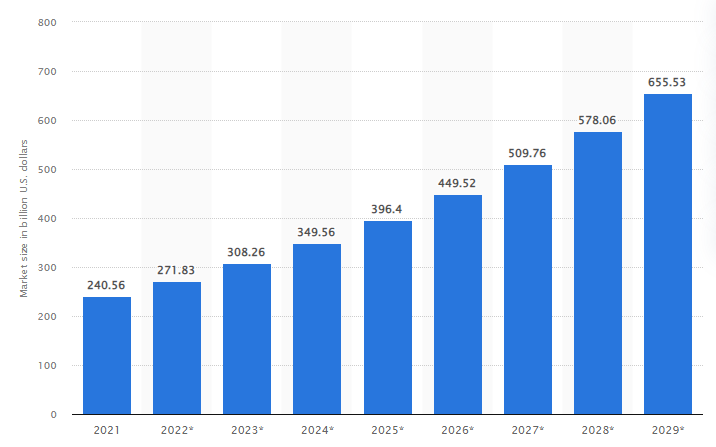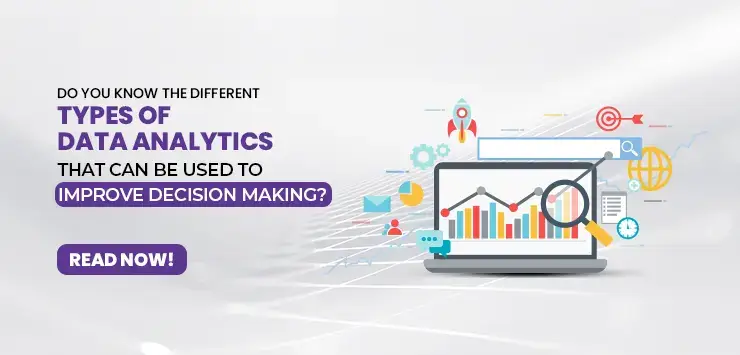Making informed decisions has always been a priority of businesses. Well, at least for those serious about staying ahead of the curve. Most companies worldwide are susceptible to making decisions based on what they feel must be right.
This includes startups, small businesses, and mid-market entities. But as companies grow, they pay more attention to what they are doing and why they are doing it. Today, data management and analytics services are popular among companies through which they can extract insights from the data available.
So, what are data analytics and the types that enable businesses to make informed decisions? What is the right analytics approach for modern companies, and what has the future for us? Let’s find out.
What Is Data Analytics, and how does it aid business decision-making?
Data analytics is essentially the procedure or technique of processing data through set rules of statistics to extract useful information or insights. Simply put, your raw and random data can be transformed into meaningful information that can be used to make conclusions.
Data talks, and through the right data analytics approach, businesses can hear and understand what the data tells them to choose their course. By implementing specific performance metrics, data can be used to get the information that leads to informed decision-making.
Multiple types of data analytics can be used to process data and get the correct information. Let’s look at how you can use them to improve business decision-making.
Types of Data Analytics
There are four types of analytics – or four types of data analytics that are used as per requirements and complexity. Usually, the more complex it is, the better it is for businesses in terms of value.
· Descriptive Analytics
Descriptive analytics tells what has happened over the period. Have sales increased in the last quarter? Did user acquisition spike the previous month? Were there more website visitors last month? All this is understood through descriptive analytics.
This type of data analytics takes in data from multiple sources, processes it, and provides valuable information and insights into the past, telling what has happened. Yet, businesses don’t get to know about the reasons behind a specific behavior or pattern.
For example, if your sales were down for January 2023, it would simply tell it. But if you want to know why the sales were down, you will have to probe into it and find out the details. In simple words, you will understand that something right or wrong has happened without knowing why.
This type of data analytics approach is better suited for small to medium-sized companies with less reliance on data analytics. For more prominent companies and enterprises, Veraqor’s data consultants advise combining the solution with other types to get more fruitful results.
· Diagnostic Analytics
To find out the reasons behind an occurrence, a pattern, or a behavior, companies turn to diagnostic analytics, another type of data analytics. Diagnostic analytics requires more data compared to descriptive analytics, and it uses a variety of data to draw conclusions.
For example, did Christmas result in improved sales figures in the last quarter of the year? Did the shift in focus on customer experience spike user acquisition? Did the new marketing campaign boost the number of users coming to the website? Diagnostic analytics tells why something has happened.
Historical data can be used to analyze to find the answers to why something has happened. It enables detailed insights into a specific domain. However, this would not be possible without a significant amount of data being available,or extracting the correct information can become a time-consuming matter.
· Predictive Analytics
Predictive analytics tells what is likely to happen in the future. What were the sales figures for last season? What change did we monitor the last time we tweaked the model to focus on customer experience? What happened with the number of website users during a similar marketing campaign?
The predictive analytics model utilizes the outcomes of descriptive and diagnostic models to predict the most-likely trends by assigning points and detecting clusters and exceptions – making it an efficient technique to forecast and define a course.
Moreover, among the stages of analytics, predictive analytics is known as one of the advanced stages of analytics which also uses the capabilities of machine learning and deep learning along with a proactive approach that predicts the likely outcome.
But Veraqor’s experts warn that the forecast made is merely an estimate that significantly depends on data quality, the similarity of the situation, and careful analysis of it. All these factors combine to bring the right information to the table.
· Prescriptive Analytics
This type of data analytics, known as prescriptive analytics, suggests what needs to be done. For example, if the production environment is suitable and the units produced are sufficiently based on the market requirements above 70%, there should be extra effort, and there might be an increase in sales.
Prescriptive analytics prescribes the actions or activities that will eliminate a threat or a problem and enable maximum utilization of the surroundings, atmosphere, or trends. Modern and advanced techniques and tools are used to run complex algorithms and rules to get forecasts.
Furthermore, at this stage of data analytics, multiple data points are needed, including internal and historical data as well as external data and information – the nature of algorithms require all this information to process data appropriately.
That is why it is strongly recommended that in-depth analysis and research must be done to avoid miscalculations, knowing the amount of effort needed and the result – both in numbers and in terms of value-addition.
Business-Focused Analytics Approach in Today’s Fast-Paced World
Everyone agrees that business dynamics have drastically changed over the past few years and continue to evolve as we look further. In times like these, it is often hard to predict what will happen next while fully understanding the background and rationale behind it.
That is where data analytics solutions emerge and show businesses a new path. Organizations can derive better decisions through quick and efficient data integration for multiple teams.
Here’s what businesses get information about:
· The market, competitors, trends, and forecasts
· Customers, their pain points, and how to reach them
· Predictions and possibilities based on the past
Using technology, there is a lot that businesses can achieve by employing the right analytics approach. For that, it is necessary to understand the ins and outs of the business needs, and then multiple analytics categories can be implemented.
Are you a Chief Marketing Officer
exploring the right solution to improve productivity and increase business
performance? Explore our Technology
Solutions for CMOs.
Which Companies Require Data Analytics Solutions?
There are companies, small and big, using multiple types of data analytics to complement their decision-making. Companies that make decisions based on what feels right or what feels wrong can survive up to a specific point.
However, after that particular period, data-driven decision-making becomes a necessity. As per a study, global data analytics was valued at around $240 billion in 2021 and is forecasted to surpass the $655 billion mark by 2029 (see the figure below).

Data Analytics Techniques
· Factor Analysis
Factor analysis focuses on analyzing the factors. It is usually done by taking a large dataset which is processed and shrunk to a smaller dataset. This allows us to understand and uncover details and trends that might not be easy to access.
· Regression Analysis
Regression analysis is a widely known and understood technique. This method analyzes the relationship between the dependent variables to determine how altering one variable impacts or affects the other.
· Monte Carlo Simulations
This model is used to find out different probabilities of the expected outcomes. It is generally used for loss prevention and risk mitigation. By taking in more variables, and values, this has greater forecast capabilities compared to other data analytics approaches.
· Cohort Analysis
Cohort analysis is a method where a dataset is broken into multiple smaller groups of similar data, which is further segregated based on customer demographics. This helps data analysts to drive helpful business information and find relevant numbers.
· Time Series Analysis
The time series analysis model tracks data and gradually improves the relationship between the data points. This method is popular for repetitive or recurring trends or financial forecasting needs and presents the data accordingly.
Business Benefits of Data Analytics
Out of several data analytics approaches discussed above, there are certain benefits or advantages common among all. Let’s quickly have a look at them.
- It heavily supports your informed decision-making process
- It increases the efficiency of work done across the organization
- It helps predict customer’s behavioral changes over time
- It enables the personalization of business offers to different clients
- It expedites innovation, ideas, and business growth across departments
Conclusion
We all know how our world is dependent on data and information. Modern statistical analysis and data analytics solutions have helped businesses utilize their data effectively worldwide. Multiple tools and techniques are now used to implement multiple types of data analytics solutions to implement a targeted analytics approach.
By knowing the end goal, data analytics can be implemented without much hassle to extract the right information. Numbers that may seem raw initially can be transformed into valuable, informative insights that enable better decision-making.



